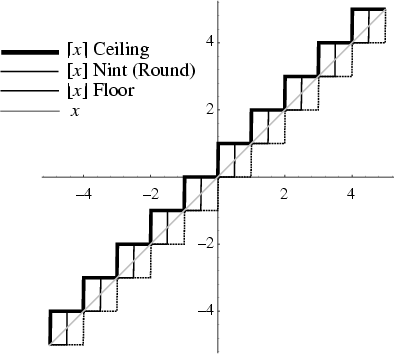|
|
|

The function
![]() is the largest Integer
is the largest Integer ![]() , shown as the dashed curve in the above plot, and also called
the Greatest Integer Function. In many computer languages, the floor function is called the Integer Part
function and is denoted int(x). The name and symbol for the floor function were coined by K. E. Iverson (Graham et al.
1990).
, shown as the dashed curve in the above plot, and also called
the Greatest Integer Function. In many computer languages, the floor function is called the Integer Part
function and is denoted int(x). The name and symbol for the floor function were coined by K. E. Iverson (Graham et al.
1990).
Unfortunately, in many older and current works (e.g., Shanks 1993, Ribenboim 1996), the symbol ![]() is used instead of
is used instead of
![]() . Because of the elegant symmetry of the floor function and Ceiling Function symbols
. Because of the elegant symmetry of the floor function and Ceiling Function symbols
![]() and
and
![]() , and because
, and because ![]() is such a useful symbol when interpreted as an Iverson Bracket, the use of
is such a useful symbol when interpreted as an Iverson Bracket, the use of ![]() to
denote the floor function should be deprecated. In this work, the symbol
to
denote the floor function should be deprecated. In this work, the symbol ![]() is used to denote the nearest integer
Nint function since it naturally falls between the
is used to denote the nearest integer
Nint function since it naturally falls between the
![]() and
and
![]() symbols.
symbols.
See also Ceiling Function, Fractional Part, Int, Iverson Bracket, Nint
References
Graham, R. L.; Knuth, D. E.; and Patashnik, O. ``Integer Functions.'' Ch. 3 in
Concrete Mathematics: A Foundation for Computer Science. Reading, MA: Addison-Wesley, pp. 67-101, 1990.
Iverson, K. E. A Programming Language. New York: Wiley, p. 12, 1962.
Ribenboim, P. The New Book of Prime Number Records. New York: Springer-Verlag, pp. 180-182, 1996.
Shanks, D. Solved and Unsolved Problems in Number Theory, 4th ed. New York: Chelsea, p. 14, 1993.
Spanier, J. and Oldham, K. B. ``The Integer-Value Int(
![]() ) and Fractional-Value frac(
) and Fractional-Value frac(![]() ) Functions.''
Ch. 9 in An Atlas of Functions.
Washington, DC: Hemisphere, pp. 71-78, 1987.
) Functions.''
Ch. 9 in An Atlas of Functions.
Washington, DC: Hemisphere, pp. 71-78, 1987.